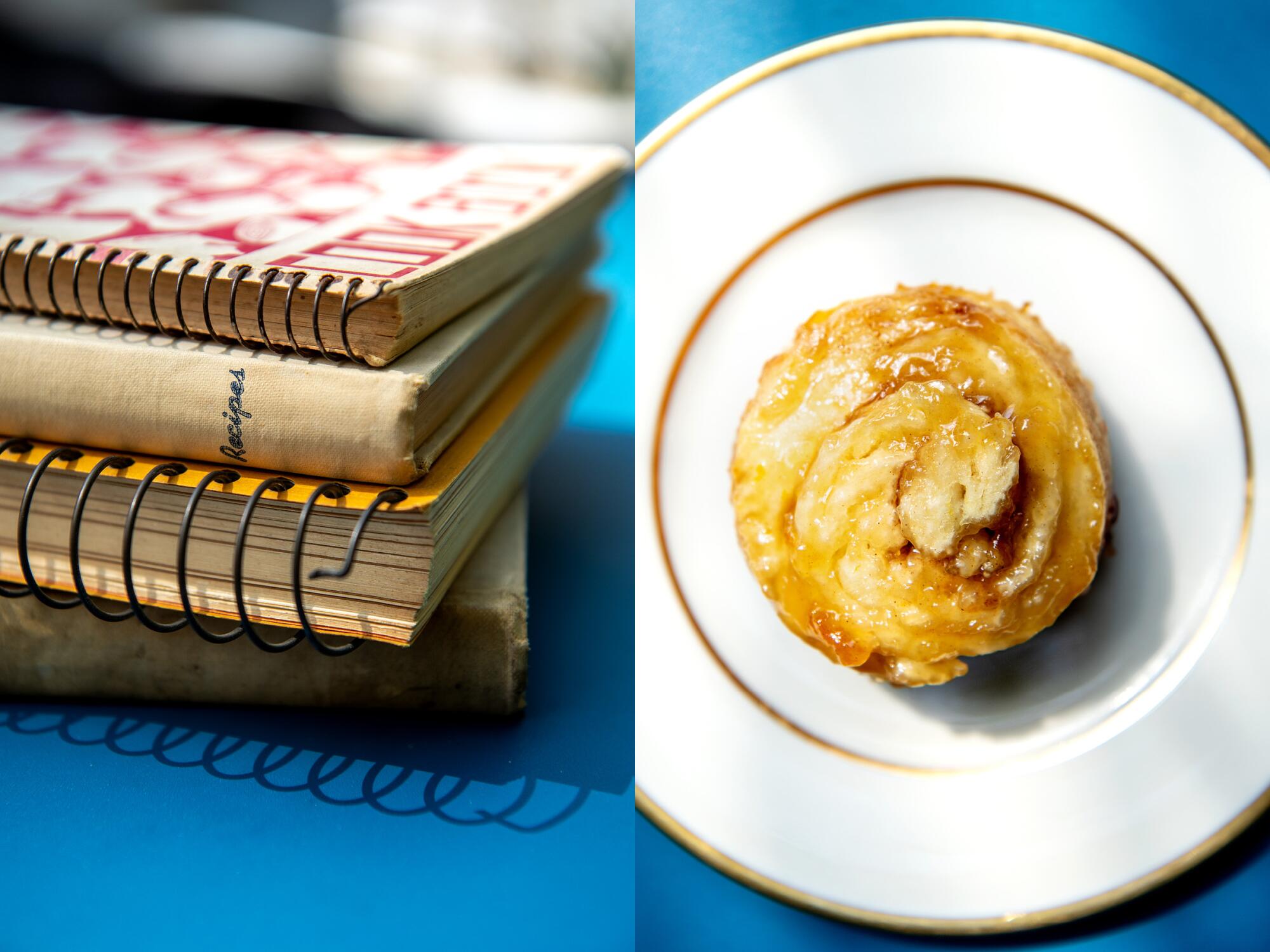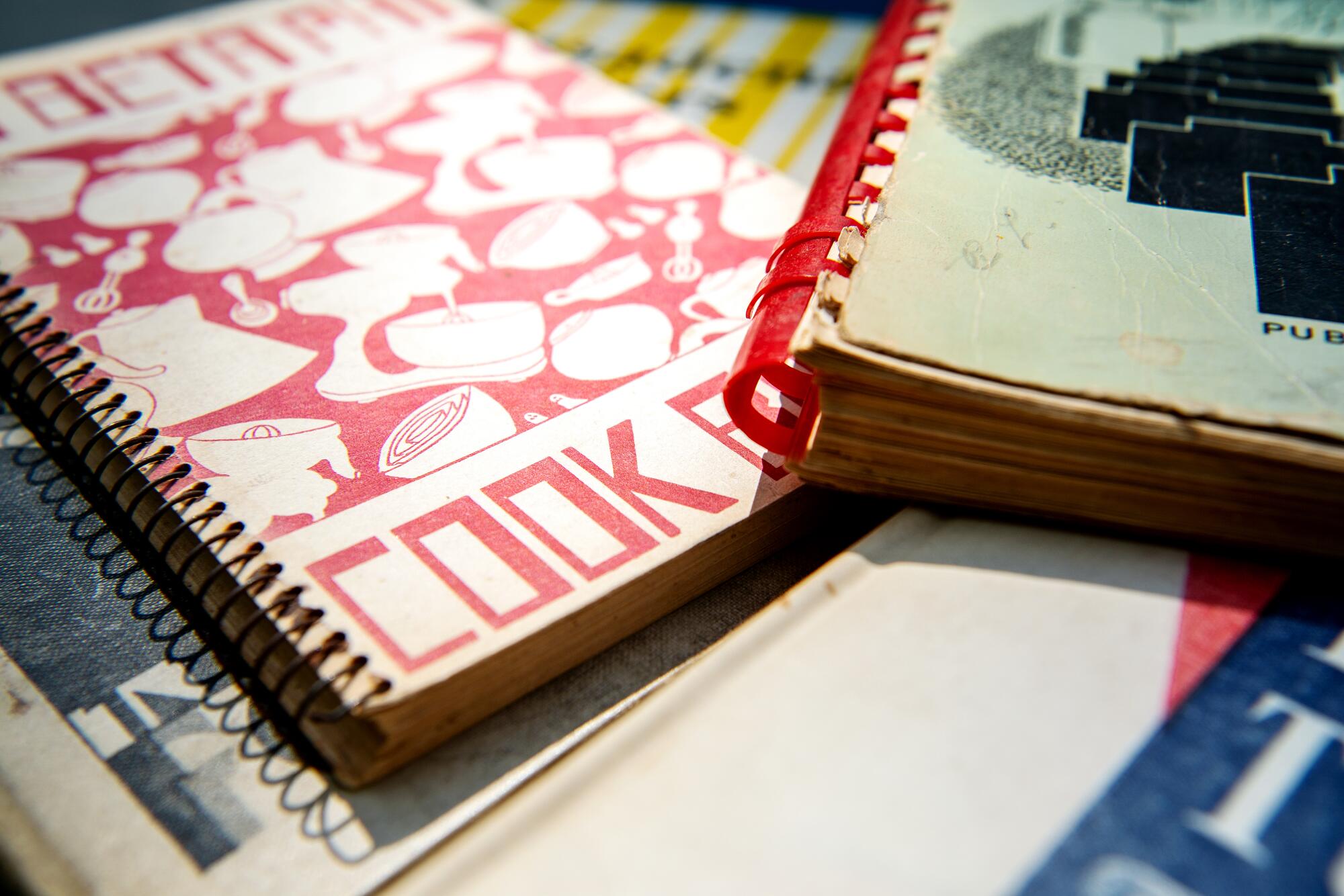
An archive of community cookbooks shows that soy and almond milks are nothing new to Los Angeles cooking.
- Share via
“This is ‘The Castelar Creche Cook Book’,” says artist Suzanne Joskow on a recent morning on the porch of her house in Hollywood. Holding the weathered, century-old green hardcover delicately, she explains that two dishes she has prepared, the California chews and the Van Nuys fruit cocktail, are taken directly from this relic.
The book was published in 1922, the same year her house was built. The chews, on Page 217, resemble granola bars and are a delightfully chewy combination of dates and nuts. The fruit salad, on Page 22, is diced and drenched in Maraschino liqueur.
“You can time travel,” Joskow says. “This recipe might have been eaten here, 100 years ago.”

Originally published as a fundraiser for L.A.’s “home for homeless babies,” a center for newborns that operated in the early 20th century, “The Castelar Creche Cook Book” is an incredible artifact of L.A. culinary history. It is now part of Joskow’s growing collection of vintage community cookbooks called the Community Cookbook Archive: L.A. In addition to collecting and archiving these books, Joskow has made it her project to cook and photograph many recipes that might otherwise fall into the dusty corners of local history.
“Sometimes they’ve been sitting there in the store for 20 years,” says Joskow, whose visual art has previously focused on maps of historically significant locations in Los Angeles. “I found them so interesting as documents. Once I started to have this group of them, I realized, this is this incredible picture of Los Angeles over time, historically.”
Often buried at the bottom of boxes at estate sales or at used bookstores, the books are from all over L.A. County and date as far back as 1894, and total almost 400. The open-ended archive is now featured as part of the “Something in Common” exhibit at the Los Angeles Central Library, which showcases a wide range of community groups around the city, and will be on view until early November.
“You get a snapshot of all of these simultaneous experiences of place,” Joskow says. “The way people eat and the way people talk about their food just tells you so much.”

Joskow will be discussing many of the cookbooks in a virtual talk on Thursday afternoon at the Central Library.
Upon entering the vibrant exhibition space in the library’s Getty Gallery, visitors can see Joskow’s work prominently displayed. Ninety-nine thoughtfully selected cookbooks line the walls. At first glance, it is a cheerful display of charming relics perched against a bright orange wall. Many have hand-drawn cover art and plastic spiral binding. The archive as a whole, like an Impressionist painting, reveals a richer picture of Los Angeles, each book a brushstroke or pixel in the larger historical narrative of the city.
One of the most apparent themes is that these cookbooks contain mostly recipes from women.
“So many of these were women-oriented because women were excluded from so many places,” Joskow says. “So, a lot of these groups are sort of women’s responses to spaces that they weren’t part of, or the things that their husband did that was not accessible to them. So the woman created a kind of auxiliary to that.”

She gives the example of “Mission in the Kitchen” from the Air Force Officers Wives Club, published in 1963, which features such recipes as tomato aspic with marinated vegetables — a bright red jiggly bundt-shaped gelatin surrounded by cold pickled vegetables. Others include “Y Wives Cookbook” from the Downey YMCA from 1968, “Cop’s Cookery: Wives of Los Angeles Police Officers” from 1977 and “Hints to Housekeepers” from members of the Woman’s Relief Corps, many of whom were wives of veterans of the Civil War, from 1907.
“The cookbooks were often fundraising tools that women would sell to their friends,” Joskow says, noting that women’s groups had to be creative in fundraising while men’s organizations may have had access to more traditional kinds of capital. “Because the domestic kitchen was so frequently the domain of women, cookbooks were compiled by, shared among and sold among women, often as fundraisers, either for a women’s group or as the women’s fundraising arm of an institution like a church.”
The foreword of “Desserticide: Desserts Worth Dying for,” a book compiled by the mystery writers group Los Angeles Chapter of Sisters in Crime, for example, declares a mission to “combat discrimination in the mystery field, educate publishers and the general public as to the inequalities in the treatment of female authors.”
They’re a better read than many novels. And you can cook from them.
“Men show up in the cookbooks earlier than you would think,” says Joskow, noting Charlie Chaplin’s contribution to the “Celebrated Actor-Folks’ Cookeries” book, a fundraiser for the Red Cross in 1916, one of many Hollywood-oriented cookbooks.
“I think a lot about Hollywood as both a physical place that is Los Angeles, and then of course, Hollywood as a kind of fantastical idea,” she says, pointing to the Hollywood Bowl cookbooks from 1984 and 2002, with picnic-ready recipes like applesauce cornmeal muffins. Joskow has made the muffins and brought some to the summer music venue along with the cookbook — as she enjoys returning the books to their original sites.
Entertainers and industry professionals show up throughout the collection, with recipes from people like trailblazing actor and producer Mary Pickford and the cast of the 1997 film “Soul Food.”
Health food-obsessed
In addition to underscoring the influence of show business, the archive sheds light on L.A.’s obsession with so-called health foods. Many of the cookbooks demonstrate early thinking around raw food and vegetarianism, as well as appreciation for Los Angeles as the hub of a bountiful West with an abundance of agricultural produce.

“Our understanding of L.A. at the forefront of food and health has a very long history,” Joskow says.
One of the best examples of this is a book called “Diet for Health,” a compilation of recipes sent to Philip M. Lovell for his L.A. Times column “The Care of the Body,” from 1928. It includes health-focused recipes and pages devoted to recipes for almond, coconut, oat and soy milks.
Yes, alternative milks were being made in Southern California about 100 years ago.
Plus, where Times writers love to take out-of-town guests to eat
The books also reveal glimpses into issues of racial and cultural misattribution. “There’s a lot of euphemistic use and purposeful mixing of ‘Spanish’ versus Mexican origins of recipes. You see it, all the way back to [a] 1905 cookbook. There are sort of Spanish recipes, some of which have Spanish origins, and some of which are kind of purposeful Europeanizing of Central American food,” Joskow says.
There are Lakers cookbooks from 1985 and 2001, with recipes, if not from the players themselves, from some of their wives and mothers.
The only completely unattributed book, “The Gay of Cooking,” from 1983, is authored under the pseudonym “The Kitchen Fairy and Friends.” Filled with humor, innuendo and well-tested recipes, its presumably gay author’s anonymity reflects the era. “This is a time where perhaps it would have been an unsafe thing to include the names of contributors,” says Joskow in a video component of the exhibit.
Each book is a time capsule. And though they remain behind glass, Joskow’s hope is that they will be brought to life through cooking. This is why she has made all of the cookbooks available for viewing and cooking online, through her website communitycookbookarchive.org.

For the record:
5:06 p.m. Sept. 16, 2022Todd Lerew is director of special projects for the Library Foundation of Los Angeles, not of the Los Angeles Public Library.
“More often than not, these types of books aren’t saved and preserved in any official archive, whether it’s an academic institution or civic, such as this one,” says Todd Lerew, director of special projects for the Library Foundation of Los Angeles, who curated the “Something in Common” exhibit. “So it’s pretty uncommon to see these brought together with the mind of preservation and study.”
Lerew developed the concept for the exhibit in 2018, before the pandemic.
“While it was hard to have the exhibit delayed, at the same time, it took on this whole other level of meaning,” Joskow says. “Because we all are so much more aware of the ways that we gather and how much value that has.”
L.A. Made: Cookbook Archive discussion
Join Suzanne Joskow for a live virtual talk on the the L.A. community cookbook archive, Thursday, Sept. 15, at 4 p.m., part of the LAPL exhibit “Something in Common.” More info: lapl.org/whats-on/events/cookbook-archive
More to Read
Eat your way across L.A.
Get our weekly Tasting Notes newsletter for reviews, news and more.
You may occasionally receive promotional content from the Los Angeles Times.











